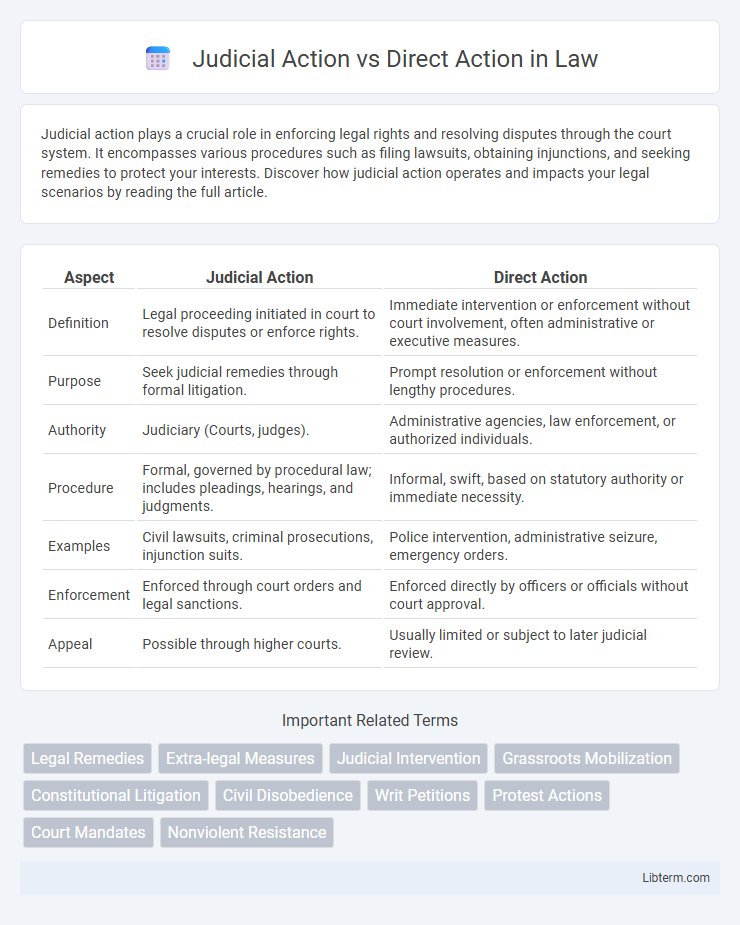Judicial action plays a crucial role in enforcing legal rights and resolving disputes through the court system. It encompasses various procedures such as filing lawsuits, obtaining injunctions, and seeking remedies to protect your interests. Discover how judicial action operates and impacts your legal scenarios by reading the full article.
Table of Comparison
| Aspect | Judicial Action | Direct Action |
|---|---|---|
| Definition | Legal proceeding initiated in court to resolve disputes or enforce rights. | Immediate intervention or enforcement without court involvement, often administrative or executive measures. |
| Purpose | Seek judicial remedies through formal litigation. | Prompt resolution or enforcement without lengthy procedures. |
| Authority | Judiciary (Courts, judges). | Administrative agencies, law enforcement, or authorized individuals. |
| Procedure | Formal, governed by procedural law; includes pleadings, hearings, and judgments. | Informal, swift, based on statutory authority or immediate necessity. |
| Examples | Civil lawsuits, criminal prosecutions, injunction suits. | Police intervention, administrative seizure, emergency orders. |
| Enforcement | Enforced through court orders and legal sanctions. | Enforced directly by officers or officials without court approval. |
| Appeal | Possible through higher courts. | Usually limited or subject to later judicial review. |
Understanding Judicial Action
Judicial action refers to the process where courts interpret and enforce laws based on petitions or complaints filed by affected parties, ensuring legal rights are upheld through formal judicial procedures. It involves adjudication by a judge or judicial body to resolve disputes, enforce statutes, or review government actions. Understanding judicial action requires recognizing its role in maintaining rule of law, protecting constitutional rights, and providing remedies through legal judgments.
Defining Direct Action
Direct action refers to activities undertaken by individuals or groups to achieve political or social objectives without relying on legal or institutional channels, including protests, strikes, sit-ins, and civil disobedience. In contrast, judicial action involves pursuing remedies through courts by filing lawsuits or petitions to enforce rights or challenge laws. Direct action emphasizes immediate intervention and public demonstration to provoke change outside formal judicial processes.
Key Differences Between Judicial and Direct Action
Judicial action involves resolving disputes through formal legal processes within courts, relying on judicial authorities to interpret and enforce laws, whereas direct action bypasses litigation by applying immediate pressure such as protests or strikes to achieve objectives. Key differences include the reliance on legal frameworks and judicial decisions in judicial action compared to the extrajudicial, grassroots approach characteristic of direct action. Judicial action typically requires adherence to procedural rules and formal evidence, while direct action emphasizes swift, public demonstration to influence change outside judicial systems.
Historical Overview of Judicial Action
Judicial action has its roots in ancient legal systems where courts were the primary venues for resolving disputes and enforcing laws, dating back to civilizations such as Mesopotamia and Rome. Over centuries, judicial action evolved through codifications like the Magna Carta and the development of common law, solidifying the judiciary's role in interpreting statutes and protecting individual rights. This historical foundation established judicial action as a critical mechanism for maintaining legal order and providing remedies through courts.
Notable Examples of Direct Action
Direct action includes various forms of protests like sit-ins, strikes, or blockades aimed at creating immediate social or political change without relying on legal processes. Notable examples include the 1960 Greensboro sit-ins during the Civil Rights Movement and the 2011 Occupy Wall Street protests, which both leveraged mass participation to challenge systemic injustices directly. These actions bypass courts, contrasting with judicial actions that seek redress through lawsuits or legal rulings.
Legal Implications of Judicial Action
Judicial action involves formally bringing a dispute before a court, resulting in legally binding judgments enforceable by law, while direct action bypasses courts and relies on protests or strikes to achieve goals. The legal implications of judicial action include adherence to procedural rules, rights to appeal, and enforceability of court orders, ensuring due process and protections under the law. Judicial action establishes clear legal precedents and provides remedies sanctioned by the judiciary, distinguishing it from the extrajudicial nature of direct action.
Social Impact of Direct Action
Direct Action, involving protests, sit-ins, and civil disobedience, creates immediate social impact by raising public awareness and pressuring institutions for change more rapidly than Judicial Action, which relies on court rulings and legal procedures. Social movements using Direct Action often mobilize communities, influence public opinion, and catalyze policy reforms through visible and collective efforts. This approach empowers marginalized groups to voice grievances and disrupt status quo, accelerating social justice outcomes beyond the slower, procedural nature of Judicial Action.
Effectiveness: Judicial Action vs Direct Action
Judicial action offers a structured legal framework that ensures enforcement of rights through court decisions, providing long-term remedies and legal precedents. Direct action, such as protests or strikes, can rapidly generate public attention and pressure, often influencing immediate change but lacking formal legal authority. Effectiveness depends on context: judicial action guarantees legitimacy and enforceability, while direct action excels in mobilizing collective power for swift responses.
Challenges and Criticisms
Judicial action faces challenges such as prolonged litigation, limited access to justice, and judicial bias, which can hinder fair outcomes and delay the resolution of disputes. Direct action encounters criticisms for potentially disrupting public order, bypassing legal procedures, and risking escalation of conflicts without formal adjudication. Both approaches face scrutiny over effectiveness, legitimacy, and the balance between enforcing rights and maintaining social stability.
Choosing the Right Approach for Social Change
Judicial action involves using courts to interpret laws and secure legal remedies, often addressing individual rights and setting precedents that influence broader social policy. Direct action entails grassroots mobilization, protests, and civil disobedience to create immediate public pressure and raise awareness for social issues. Choosing the right approach depends on factors such as the urgency of the change, the legal framework, public support, and the desired scope of impact in advancing social justice.
Judicial Action Infographic

 libterm.com
libterm.com